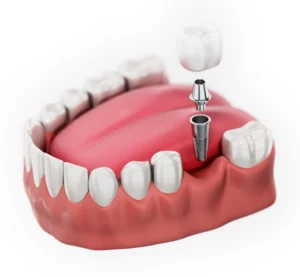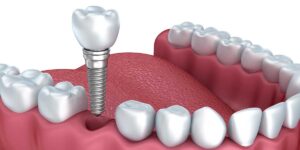Replacing a missing tooth can significantly impact your oral health and confidence. Single tooth implants are the best solution for those looking to restore their smile and functionality effectively.
Single tooth implants are titanium posts surgically inserted into the jawbone to support a dental crown. This Single tooth implants will guide you through the benefits, process, and long-term care of single tooth implants.
Key Takeaways
- Single tooth implants effectively replace missing teeth by mimicking the natural tooth structure.
- The procedure involves a surgical process followed by a healing period.
- Implants offer several benefits, including improved oral health, aesthetics, and functionality.
- Proper care is essential to maintain the implant’s longevity.
Benefits of Single Tooth Implants

Single tooth implants are an excellent choice for several reasons. Here are some key benefits:
- Improved Oral Health: Implants help maintain the jawbone’s integrity, preventing bone loss that often occurs with missing teeth.
- Natural Appearance: Dental implants closely resemble natural teeth, making them nearly indistinguishable from your other teeth.
- Durability and Longevity: With proper care, dental implants can last for decades, making them a long-term solution.
- Functionality: Implants restore full chewing ability, allowing you to eat your favorite foods without discomfort.
- Convenience: Unlike dentures, implants are permanent and do not require removal for cleaning or sleeping.
Understanding the Single Tooth Implants Procedure

The process of getting a single tooth implant involves several steps. While it may seem daunting, each stage is essential for the success of the implant.
Initial Consultation
During the initial consultation, your dentist will evaluate your oral health to determine if you are a suitable candidate for a dental implant. This involves:
- X-rays and Scans: Imaging helps assess the health of your jawbone and the exact location for implant placement.
- Health Review: Your medical history will be reviewed to ensure no underlying conditions could affect the implant procedure.
Surgical Placement
- Anesthesia: Local anesthesia is administered to numb the area where the implant will be placed.
- Incision: A small incision is made in the gum to expose the jawbone.
- Drilling: A hole is drilled into the jawbone where the titanium post will be inserted.
- Implant Insertion: The titanium post is carefully placed into the drilled hole, acting as a root for the new tooth.
- Stitching: The gum is sewn back over the implant to promote healing.
Healing and Osseointegration
After the implant is placed, it must heal and integrate with the jawbone, a process known as osseointegration. This can take several months, during which:
- The titanium post fuses with the bone.
- Temporary crowns or bridges may be provided to maintain aesthetics and functionality.
Final Restoration
Once healing is complete, a custom-made crown is attached to the implant. This involves:
- Abutment Placement: The gum is reopened to attach an abutment to the implant.
- Impression Taking: An impression of your mouth is taken to create a custom crown.
- Crown Attachment: The custom crown is securely attached to the abutment, completing the process.
Comparison of Single Tooth Implant vs. Dental Bridge
| Feature | Single Tooth Implant | Dental Bridge |
|---|---|---|
| Bone Preservation | Yes | No |
| Durability | High (20+ years) | Moderate (10-15 years) |
| Adjacent Teeth Impact | Minimal | High |
| Cleaning | Similar to natural teeth | Requires special care |
| Cost | Higher initial cost | Lower initial cost |
Real-Life Experiences
Many patients report significant improvements in their quality of life after getting a single tooth implant. Here are some testimonials:
- Jane, 45: “I was hesitant about the surgery, but the results were worth it. My implant feels just like a natural tooth.”
- Mark, 52: “I used to struggle with eating certain foods, but my implant changed that. I can enjoy my meals again.”
Long-Term Care for Implants
Caring for your dental implant is crucial to ensure its longevity. Here are some tips for maintaining your implant:
- Regular Brushing and Flossing: Maintain good oral hygiene by brushing twice a day and flossing daily.
- Routine Dental Checkups: Regular visits to your dentist will help monitor the implant and surrounding teeth.
- Avoid Hard Foods: Chewing on hard foods can damage the crown and implant.
- Quit Smoking: Smoking can interfere with the healing process and increase the risk of implant failure.
Common Myths about Dental Implants
| Myth | Truth |
|---|---|
| Implants are painful | Most patients report minimal discomfort |
| Implants are expensive | Long-term benefits outweigh the initial cost |
| Implants require special care | Regular oral hygiene is sufficient |
| Implants are only for the elderly | Suitable for adults of all ages |
| Implants look fake | Custom crowns are designed to match natural teeth |
Common Questions about Single Tooth Implants
How long does the entire process take? The complete process, from initial consultation to final crown placement, can take several months. This includes healing time for the implant to integrate with the jawbone.
Are there any risks involved? As with any surgical procedure, there are some risks, such as infection, implant failure, or nerve damage. However, these risks are minimal when performed by a skilled dentist.
Is the procedure covered by insurance? Dental implant coverage varies by insurance plan. It’s best to check with your insurance provider to understand your coverage options.
What if I don’t have enough bone for an implant? In cases where there is insufficient bone, procedures like bone grafting can help build up the bone to support an implant.
Steps to Prepare for a Single Tooth Implant
- Consult with your dentist: Discuss your options and undergo necessary evaluations.
- Plan your schedule: Allocate time for the procedure and recovery.
- Follow pre-surgery instructions: Your dentist may provide specific guidelines to follow before the surgery.
- Arrange transportation: Ensure you have someone to drive you home post-surgery.
- Prepare soft foods: Stock up on soft foods for the initial healing period.
Key Takeaways
Single tooth implants are a reliable and effective solution for replacing missing teeth. They offer numerous benefits, including improved oral health, natural appearance, and long-term durability. Understanding the procedure and committing to proper care can ensure the success and longevity of your dental implant. If you’re considering a single tooth implant, consult with a qualified dentist to discuss your options and get started on your journey to a restored smile.
For further information or to schedule a consultation, contact us at Inspire Dental in Ottumwa, Iowa. Our team is dedicated to providing personalized care and ensuring your dental health.
By focusing on the benefits, the step-by-step procedure, and real-life experiences, this article aims to provide comprehensive and unique insights into single tooth implants. The information is presented in an accessible manner and avoids common jargon, ensuring that it appeals to a wide audience. If you have any specific preferences or additional details you’d like included, please let me know!
